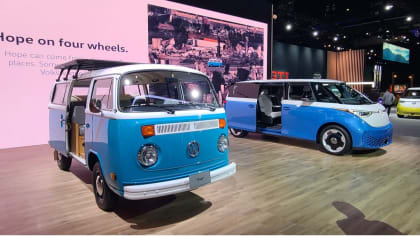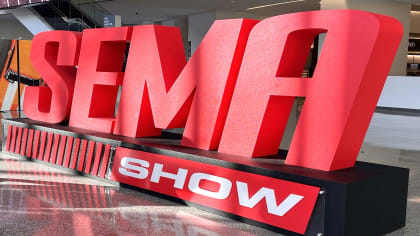AUTO CLUB 400
How To Make NASCAR Relevant Again
This article is from our archives and has not been updated and integrated with our "new" site yet... Even so, it's still awesome - so keep reading!
Published on Fri, Mar 20, 2015
By: The LACar Editorial Staff

By Brian Kennedy
The racing’s coming, but does So Cal care? That’s the question ahead of the Auto Club 400 at the two-mile speedway in Fontana on the weekend.
The answer to that question is in part the answer to a larger question—how relevant is NASCAR in an age of a lower driving rate amongst young people and the growth of blood sports (MMA) as the country’s most popular form of entertainment?
It used to be that the series filled its tracks every weekend. The number of races increased nearly every year over the period from, say, the late 1980s until around 2000. Then things hit the skids, particularly after the big economic crash of 2008. People explained it as the loss of blue collar jobs. No extra money means no tickets to the races. Maybe that was it, but there’s much more, and there are remedies too. I’d like to lay out both the problems and the fixes in what follows.
To start, the loss of Dale Earnhardt at Daytona in 2001 killed a lot of fan interest, and it wasn’t that people were horrified at what had happened and thus decided to stay away. They just never quite embraced anyone else like they had him. His fame was not unprecedented. Before him, there were lots of big names. In recent memory, Bill Elliott was as popular in his time as Earnhardt was in his decade. But after Dale, nobody else really came close. Gordon was (is) as hated as he was loved. Jimmie Johnson the same. Kevin Harvick, Tony Stewart, Matt Kenseth, a series of young kids called Busch and Kahne and Logano—none ever managed to transcend from driver to hero in the way that Earnhardt had. Even his own son, Dale Jr., while popular, has never been figured as superhuman.
Then there are the cars. Here’s the thing—NASCAR’s heyday, when the cars that raced actually had a real resemblance (other than a name and a few stickers) to the car you could buy, is long gone. “Brand identity” is a term that drivers were throwing around a year ago when the Sprint Cup and Nationwide (now Xfinity) Series came to town. What that meant is slightly more contour of body and a very lifelike decal set to mimic the headlights and rear end than for the few years prior. But nobody is fooled. That’s just not a Camry (or Fusion, or Chevy SS) out there. The closest that one of the three comes is the SS, in fact, which at least uses a V8, rear-drive platform.

In the absence of true brand identification—not “identity,” which as we know, is used for everything from getting people to join the army to getting them to buy deodorant—the series has two choices. Feature its history, or feature its tech. Neither one seems to have become “the” strategy, and the result is what you see on TV—smaller and smaller crowds. Grandstands covered with giant US flags, like we won’t notice that there’s nobody sitting in all those seats.
In theory, it should be easy to interest people in going to races. If you’ve been to one, you know—the sport is way, way better live than it is on TV. It’s complex, fast, close, loud. You can feel it in your body when the cars go by. You want to scream when all 43 of them roar by at the green flag. During the race, there’s strategy that you can’t see on TV and which is oftentimes not narrated to you. Sure, you might not know why a guy suddenly pitted, but you can see the results on the track. You can watch the battles back in the crowd. It’s a lot of fun.
But there’s a funny thing about humans—they do what others do. Crowds draw crowds. And when interest falls off, it sometimes goes off the cliff. So what can NASCAR do?
Like I said: feature the history, and feature the tech. These are two entirely different directions, so someone in a meeting somewhere would likely say that they are incompatible strategies. They’re not. They’re two sides of a coin.
First, the history. I like the images of the cars of the 50s, 60s, 70s, etc. that I sometimes see on NASCAR coverage. In fact, I could stand to see a lot more of it. I wouldn’t mind it, either, if they put some of the old races on TV. What about the first Brickyard 400, from 1994? Or name another great old race. Darlington back when it was on Labor Day (where, of course, it is once more). But wait! I’m really talking about SpeedVision (later SpeedTV) coming back, and that’s been killed in favor of yet another Fox Sports channel which almost never has anything worth watching on it.
Second, the tech. Covering the Fontana race the past couple of years, one thing I’ve noticed, and talked to crew and NASCAR staff members about, is the degree to which technology is used in the racing of 2015.
What do they never talk about on TV? The ballast weight that goes into framerails. The thousandths of an inch that everything is measured to. The fact that at any one time in the garage, two laptops might be plugged into a car to tune its ignition, fuel system, and whatnot.

The body templates. The ways they measure ride height and other rules like wheelbase. High tech, high tech, high tech, all of it. The degree to which adjustments change things. Sure, the guys who call the races will at times say something about shocks, and we’ve all seen stories of how they decide which shock package to use, the shock dynos in the haulers, etc. But there’s way more to NASCAR than that. It takes engineers to make these things run like they do.
Yep, cowboy, the good ole days of a crew chief standing out on pit road during practice, ciggie dangling from a lip, saying, “Yeah, we need another couple of pounds in the left rear” might not be gone—racing’s still a matter of feel and impression, to a degree—but at the same time, there’s a lot more, and a lot more precise, data available, and it takes brains to make it all make sense.
Why isn’t that featured on TV?
First, it might be because they’ve done focus groups and decided that people don’t want that. NASCAR is going to remain a cookies-on-the-bottom-shelf endeavor, decidedly low culture. I’m guessing here, but this assumption seems reasonable.
Second, because the people who run NASCAR don’t think it’s important to feature tech. I don’t know why that would be the case, unless they think their audience is more lowbrow than it is. Maybe that’s true in some places, but I think there’s a core of sophisticated race fans out there that want more depth and detail.
Third, because they think that the same old, same old—telling people that these are Chevys and Fords (and Toyotas, but there are a lot that resent the heck out of the Japanese manufacturer being in their sport, even though Camrys are made in the USA)—works. Make the stickers realistic enough, and people won’t notice that there’s no resemblance in any way to what’s on the showroom floor.
Really? The bodies are wider; they have a more flat plane at the tops of the doors; they are much more slab-sided; they are lower, with much bigger front air dams. I could go on. These are plain old, flat-out, no-excuses race cars, and using the silhouette argument just don’t fly no more. Yes, I said that in NASCARese. It’s a language I can speak when in the right situation.
Maybe it’s time for NASCAR to embrace the fact that it has changed, not into something which people won’t like, but into something that they will, if only given the chance. Racing now isn’t necessarily less interesting than before, though it’s less seat-of-the-pants, some would say less gutsy. In fact, it’s a multitude of times more interesting, because it’s about being smart and educated and clever. Engineering runs NASCAR now, not feel. And that’s just how it is.
The question is, are there 100,000 people in Southern California who care enough about that stuff to spend the money to see it in person? I’m betting no, but that’s a shame, because the racin’ out in Fontucky this weekend is going to be amazing.

Read Brian Kennedy's Harvick Does Hockey: The Auto Club 400 For more information about the Auto Club 400, click here.



